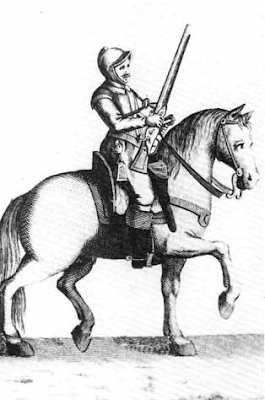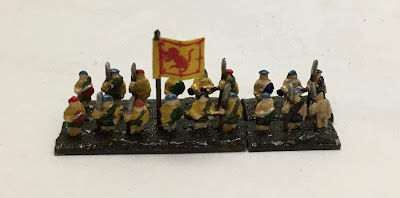Having done my best to define the key troop types used in 'Stand with me to fight the field' (I'm beginning to think that title might be a bit too long!) I had to think about the way the main armies of the period differed one from another during the period and how they evolved across it. Before starting into defining them, there are a couple of things to bear in mind.
Firstly period accounts, including drill manuals and also modern sources especially wargame guides can be a bit 'loose' in their terminology! They tend to mix and match Regiment , Battalia, Squadron, Troop and Tercio with no regard to what they actually represent. The second thing is that the actual building block for tactical units was the Company for foot or the Troop (or it's equivalent) for horse. These were not the actual tactical units but the parts which were assembled to make them. Lastly seventeenth century generals seem to have had a liking for having infantry units of the same size across their armies and to have a minimum number of them available to deploy, which means that they could be larger or smaller as circumstances dictated. Plus different armies had different views on the optimal unit size and that could differ quite dramatically!
We are used to thinking about Regiments as the tactical unit but in reality these, along with Tercios were an administrative unit which were split or merged as required to create the actual tactical formations. These tactical formations were described in a number of different ways depending on the nationality of the army and sometimes the time period. Common terms used are Battalia, Battalion, Squadron, Escuadron and of course Regiment.
Cavalry also suffer from a change in terminology across the centuries. I'm a child of the WRG ancient rules so I have distinct views on what light medium and heavy cavalry are. I suspect Napoleonic gamers share a similar mental map to mine. Seventeenth century writers seem to have had a different set of definitions. Harquebusiers and Finnish Hakkapeliitta are defined as light cavalry in a lot of sources as they are not in three quarter armour! I would define them as being the standard melee cavalry type used in the rules with Reiter's and Demi-Lancers classed as armoured to account for the three quarter armour. Light cavalry are the likes of Croats and similar types who do not charge into melee as a matter of course. So in my rules we have three categories of cavalry, Light Horse, Horse and Horse with the armoured dice modifier. I hope that makes sense.
This is a big topic (actually a huge topic if I'm being honest) so I'm going to take a few posts to look at some of the main players within the timeframe 1618-1660AD within Western and Central Europe. Starting with:
THE SPANISH
Why start with the Spanish? Well in the early years of the 17th century this was the military benchmark every other European nation measured themselves against. It was a multi-national force with troops not just from Spain but also drawn from Italians, Walloons, Germans, Swiss and Catholic volunteers from England and Ireland as well. The Spanish Army was a professional force with some excellent infantry. Their cavalry was not so well regarded and they made use of mercenary troops to offset this.
It's a difficult force to define as it evolved steadily across the period and the army of 1618 looks very different to that of the 1650's. This isn't helped by a lack of sources in English (well a lack of any sources on what formations were used in which battles is pretty scarce full stop) and a number of web based sources having disappeared, Pierre Picouet's excellent site on the Tercios being a prime example, (although I have found bits of it on the Internet archives way back machine). Other printed sources are hideously expensive as they are out of print. So what follows is the best I could come up with from those sources available to me.
The Spanish army was a conservative one which stuck with large formations deployed in depth longer than most of their contemporaries. They also continued using large numbers of Arquebus armed shot well into the 1640s. Despite being conservative in some regards their tactics were exceptionally flexible with their shot acting almost as semi independent bodies capable of acting separately to the parent body of pikemen.
THE CAVALRY
I'm starting here as it's fairly straight forward. In 1618 the Spanish cavalry consisted of just three types:
- Cuirassiers (Reiters)
- Demi-Lancers
- Harquebusiers
Light Cavalry was added in the late 1630s. Most of the heavier cavalry were supplied by German or Italian mercenaries.
 |
| Painting by Sebastiaen Vrancx cica 1610- 1615 Showing a Harquebusier, Demi-Lancer and Reiter (from Wikipedia). Probably the Siege of Ostend. |
The quality of Spanish cavalry was lower than the infantry and did not improve until 1648 when large numbers of experienced German mercenaries became available at the end of the Thirty Years War. Both native Spanish and Mercenaries fought in squadrons of around 150 - 250 horsemen. Although on occasions much larger formations were fielded to maximise the number of ranks for firepower attacks.
Demi Lancers
Armed with Lances and melee side arms. These were only available in small numbers as General's Lifeguards. I'd suggest deploying as single troops of 50 horse. They were formally abolished in 1633. They seem to have fought in shallow formations to maximise the effect of the charge. Reiters and Harquebusiers would provide fire support prior to the charge. Give a weapon reach advantage for being lance armed and the melee bonus as armoured.
Experience: Veteran & Elite
Training: Trained
Fighting style: Shock
Cuirassiers (Reiters)
 |
| Cuirassiers aka Reiters |
Armed with pistols and melee side arms. These were the commonest cavalry type in Spanish armies. Fought in 6 - 12 ranks using fire by ranks although not in the caracole style. Instead they stood and fired one or two ranks at a time before retiring to the rear of the body. After 1635 they may reserve pistols for use in melee rather than shooting from a distance. From 1635 to 1640 they started to reduce the amount of armour worn. Between those dates they may have the armoured melee trait or not. After 1640 they can no longer count as armoured as their armour was on a par with Harquebusier armour. Unit sizes of around 250 up until 1630 and 150 - 200 there after.
Experience: Before 1648 Raw or Experienced. From 1648 Experienced or Veteran
Training: Trained
Fighting style: 1618 - 1635 Mixed firepower, 1635 - 1660 Mixed shock
Harquebusiers
 |
| Harquebusier or possibly a Light Horseman (Note the lack of back and breast plate) |
Armed with an Arquebus or carbine, pistols and a melee side arm and commonly armoured with a buff coat, helmet, and back and breast plates. At the start of the period their main role was to provide fire support to the Demi-Lancers or Cuirassiers and fighting in melee was a secondary role. As cuirassier armour was reduced they became more capable of fighting in melee on an equal footing. They could also dismount and fulfil the same role as dragoons albeit with less effective fire arms. As Cuirassiers began to disappear the Harquebusier became the primary cavalry force, probably from the 1650's onwards. Unit sizes were probably the same as for Cuirassiers.
Experience: Before 1648 Raw or Experienced. From 1648 Experienced or Veteran
Training: Trained
Fighting style:1618 - 1635 Mixed firepower, 1635 - 1660 Mixed shock (if dismounted post 1635 count as mixed firepower.
Light Cavalry
 |
| 17th Century engraving of Croat light horse |
Spanish armies started to use light cavalry later than most other participants in the Thirty Years War. This was due to the nature of the warfare they engaged in which mainly consisted of sieges until 1640. It was not until 1638 that they hired similar mercenary light horse types to those in use in Imperial armies. These were sourced from Eastern Europe and would have consisted of Croats and Huzzars (Hungarian or Polish). These would be unarmoured hussars rather than the Winged Hussar heavy horse.
They were armed with arquebus or carbines, pistols and melee side arms. A lance was an option in Imperial service so this may have carried through to Croats and Huzzars in Spanish service. Count as poorly equipped horse for melee purposes. If they entered into melee they are at a disadvantage so would only do so against flanks or rear of units already engaged frontally or against a fleeing enemy. They were hired in regiments of around 500 men but these seem to have been split into 2 or 3 squadrons in combat.
Experience: Experienced
Training: Trained
Fighting style: Skirmish
DRAGOONS
Armed with a musket and sword. The Spanish only started to raise Dragoon units from 1632 onwards. Prior to this Harquebusiers had provided dismounted fire support if required. Like Harquebusiers Dragoons can shoot while mounted. They may charge and fight in melee while mounted as described in the rules. The quality of these troops was not particularly good and those engaged in fighting in Spain and Portugal had a very poor reputation. Units were around 500 strong.
Experience: Raw or experienced
Training: Part trained or trained
Fighting Style: Firepower or mixed firepower
As this post is getting a bit lengthy I will look at the Spanish Infantry in my next post.






